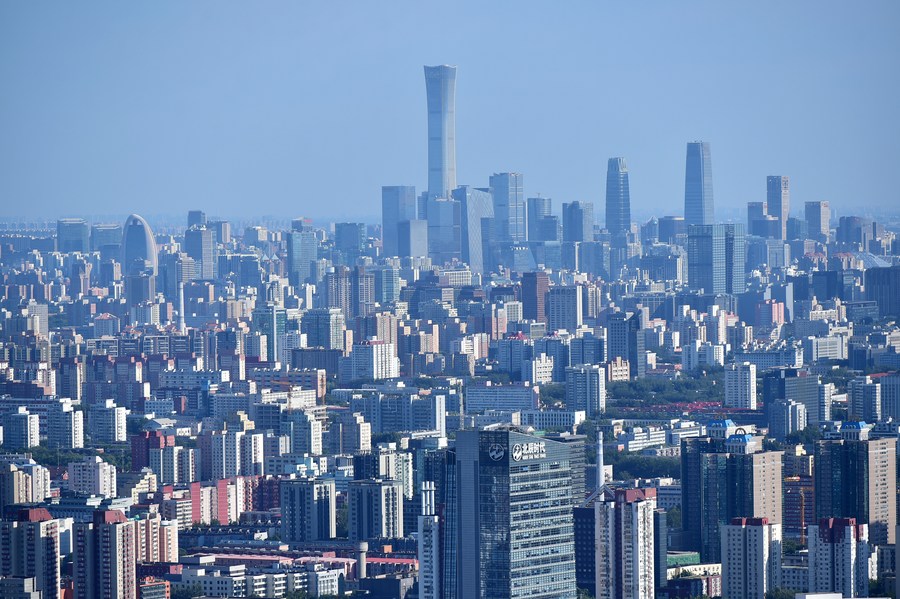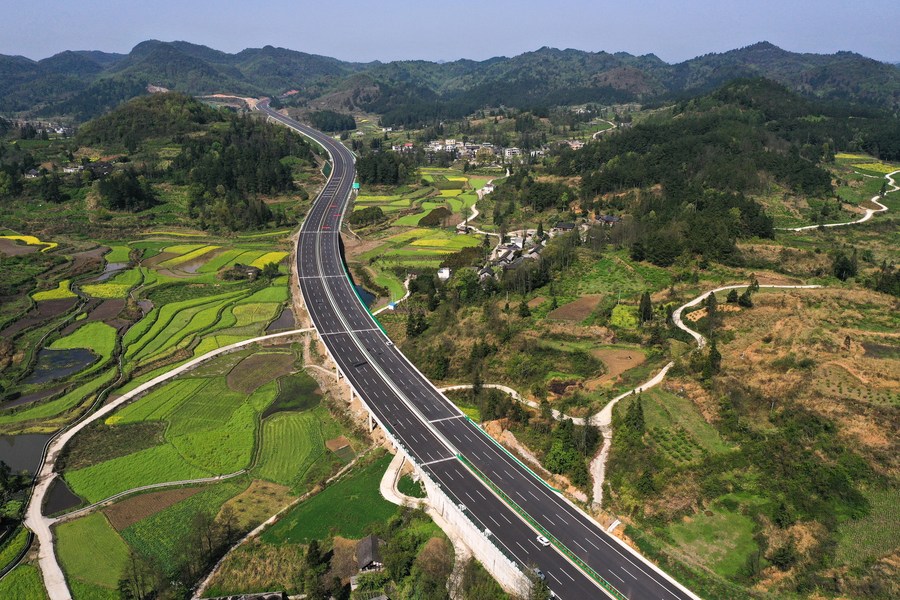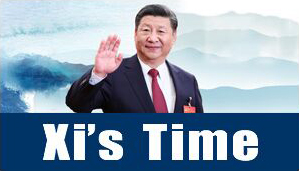
Photo taken on Sept. 9, 2020 shows the view of the skyscrapers of the Central Business District (CBD) in Beijing, capital of China. (Xinhua/Chen Zhonghao)
BEIJING, May 26 (Xinhua) -- China is facing tough challenges in promoting reform, development and stability, as both drastic changes and a pandemic unseen in a century have been transforming the international arena and thrusting the world into a new round of turbulence and shifts.
Against this backdrop, Xi Jinping, general secretary of the Communist Party of China (CPC) Central Committee, has highlighted both high-quality development and high-level security amid the country's efforts to embrace a brighter future for the Chinese economy.
PROTECT LIFE, STEADY ECONOMY
The huge "black swan" of the COVID-19 pandemic has become the biggest variable affecting the recovery of the global economy. The virus is still ravaging the world and mutating, after having resulted in some 520 million confirmed cases worldwide, and over 6 million related deaths.
Since March this year, COVID-19 resurgences have hit parts of China, markedly impacting the country's economic recovery.
Xi has stressed the importance of effectively coordinating COVID-19 prevention and control with economic and social development, protecting people's health and safety to the greatest extent, and minimizing the impacts of the pandemic on economic and social development.
Local regions have taken effective measures to check COVID-19 resurgences.
For example, earlier this year, the southern city of Shenzhen, a tech hub and a major center for foreign trade in China, saw a resurgence of COVID-19 infections. The city took a series of measures, such as suspending public transportation and closing some businesses, from March 14 to 20, and successfully brought the situation under control.
Shanghai has cut off the community transmission of COVID-19 in all its 16 districts as of May 17.
Besides fighting the virus resurgences, China has rolled out a series of policies to steady the economy and safeguard development security, involving efforts to keep logistics smooth and industrial and supply chains stable.
The country has carried out new combined supporting policies through tax and fee cuts. Tax refunds and cuts are expected to total around 2.5 trillion yuan (about 375.38 billion U.S. dollars) in 2022.
Shifts in the domestic and international economic environment have brought tremendous pressure, but the fundamentals of the Chinese economy, characterized by strong resilience, enormous potential and long-term sustainability, remain unchanged. "We have every confidence in the future of China's economy," said Xi at the virtual session of the 2022 World Economic Forum held in January.
STAY RESILIENT
Facing complicated situations at home and abroad, China has taken initiatives to ensure that key areas are safe and controllable to safeguard the bottom line of achieving high-quality development.
Global energy and grain markets have experienced volatile fluctuations, adding pressure to domestic supply and price stability.
"For a big country like China, ensuring the supply of primary goods is a major strategic issue. We must strengthen strategic planning and make early adjustments to ensure supply security," Xi said at the tone-setting Central Economic Work Conference in December 2021.
Noting that food security is critical to the country's stability and prosperity, Xi urged against slacking off on the food security issue on various occasions.
A slew of measures have been taken to ensure grain output exceeds 650 million tonnes this year. Currently, the planting area of winter wheat remains stable at 330 million mu (22 million hectares), laying a sound foundation for a bumper summer harvest.

Aerial photo taken on May 24, 2022 shows farmers harvesting wheat in the fields in Xiapo Village of Linyi, east China's Shandong Province. (Photo by Wu Jiquan/Xinhua)
As energy serves as the fundamental underpinning of economic and social development, Xi has stressed the need to safeguard the country's energy supply.
To ensure energy security, China will add an additional 300 million tonnes of coal production capacity this year. Oil and gas exploration will be strengthened, and the building of large wind power and photovoltaic bases will be accelerated. Besides, coal imports will be exempt from tax between May 1 this year to March 31, 2023.
China is also striving to strengthen scientific and technological innovation and promote tech self-sufficiency. China's indigenously developed C919 large passenger aircraft is a case in point.
"We must have our own large jets," Xi said during a visit to the Commercial Aircraft Corporation of China eight years ago.
Researchers have been stepping up efforts to overcome technical difficulties. The first C919 aircraft to be delivered completed a successful maiden test flight on May 14.
MODERN INFRASTRUCTURE AS FOUNDATION
Chairing the 11th meeting of the Central Committee for Financial and Economic Affairs held on April 26, Xi, also head of the committee, called for all-out efforts to strengthen infrastructure construction in the country's endeavor toward building a modern infrastructure system.
Calling infrastructure a pillar for economic and social development, Xi urged the country to coordinate development and security, and optimize the layout, structure, functions and development models of infrastructure.
On April 29, a meeting of the Political Bureau of the CPC Central Committee, chaired by Xi, reiterated the need to comprehensively reinforce infrastructure construction.
From the central to local authorities, a slew of arrangements have been unveiled and a blueprint of building a modern infrastructure system has been rolled out step by step.
Efforts have been made in advancing infrastructure construction with a focus on shoring up weak links, with the construction of 102 major projects for the 14th Five-Year Plan period (2021-2025) being accelerated.

Aerial photo taken on March 28, 2022 shows a section of Guiyang-Huangping Highway in Guiding county, southwest China's Guizhou Province. (Xinhua/Yang Wenbin)
Of the 800 billion yuan of investment earmarked for water conservancy projects this year, 195.8 billion yuan has been invested from January to April, surging 45.5 percent year on year.
Meanwhile, the country is also striving to build technological and digital infrastructure as a part of its long-term goal to optimize the overall economic layout and foster new growth drivers.
As part of the digital information infrastructure, the number of 5G base stations in the country increased by about 134,000 during the first quarter of the year, bringing the total to nearly 1.56 million. Earlier this year, China initiated work on a mega project to establish eight national computing hubs and 10 national data center clusters in a bid to improve overall computing power and resource efficiency.
The country's moves to comprehensively reinforce infrastructure construction and build a modern infrastructure system, with both the current needs and long-term goals taken into account, will lay a solid foundation for future development and bring opportunities for technological innovation.
ECONOMIC REORIENTATION
Amid an increasingly complex external environment, Xi has urged efforts to accelerate the building of a new development paradigm and advance China's high-quality development, seeking to reorient the country's economic growth pattern to build up resilience against global volatility.
The strategy recently got a vital boost as authorities detailed a plan on how to build a national unified market to enable a more efficient and smooth flow of labor and goods across the country.
The move is key to the country's new development paradigm of "dual circulation," floated in 2020 as a strategic solution that takes the domestic market as the mainstay while letting internal and external markets boost each other.
"To speed up the construction of a new development paradigm is to enhance our survivability, competitiveness, development and sustainability in the face of various predictable and unforeseen storms and turbulent waves, so as to ensure that the process of the great rejuvenation of the Chinese nation will not be delayed or even interrupted," Xi noted.
In the meanwhile, the focus on the domestic market does not mean neglecting the bigger global market. As "dual circulation" is by no means a closed domestic loop, Xi has expounded on how China's unlocked market potential, wider opening up and deepening international cooperation under the new development paradigm will offer more development opportunities and bring shared prosperity to the world.
To make good on the commitment, China has advanced the construction of 21 pilot free trade zones, and signed Belt and Road cooperation documents with 149 countries and 32 international organizations.
It has also prompted the implementation of the Regional Comprehensive Economic Partnership Agreement and officially filed an application to join the Comprehensive and Progressive Agreement for Trans-Pacific Partnership.
STRIVING FOR NEW SUCCESS
Engines started rumbling again at train stations in Shanghai. A shipbuilder in the city has recently delivered a large ethane carrier, the first after its operation resumed.
While COVID-hit Shanghai is returning to normalcy step by step, it now faces a race against time to regain what was lost in the epidemic.
A steadily recovering Shanghai has proved once again the resilience of the Chinese economy.
Looking forward, in its great modernization drive, China is sure to encounter various risks and challenges, some foreseeable and others not. A balance must be struck between development and security.
"We should ensure both development and security and be ever ready to protect against potential dangers in times of peace. This is a major principle underlying the Party's governance," Xi has said.
During the annual "two sessions" in March, Xi listed China's five strategic advantages, which are the strong leadership of the CPC, the institutional strength of socialism with Chinese characteristics, the solid foundation accumulated in the country's sustained and rapid development, the long-term stability of the Chinese society, and the confidence and resolve of the Chinese people to overcome difficulties.
The five advantages explain why China has succeeded and how the country can remain successful in the future.
"The world is undergoing profound changes unseen in a century, but time and situation are in our favor," which is precisely where China's composure and confidence come from, Xi has said. ■





